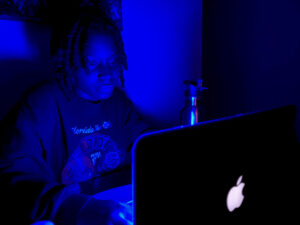
The COVID-19 pandemic continues to interrupt the education, future and wellbeing of almost every college student in America. While zooming bottomless may sound appealing to most, staring at a computer screen for hours at a time exposes everyone to blue light, which can cause digital eye strain, disruptions to the circadian rhythm, permanent eye damage and increase the risk of diseases like diabetes or heart disease.
As students typically spend two-to-three hours a day on homework, according to Howtolearn.com, screen time and vulnerability to blue light are increased as students are also attending virtual class sessions through video conferencing platforms, like Zoom.
Blue light, according to Harvard.edu, are blue wavelengths with beneficial effects that can increase attentiveness, improve reaction times, and uplift moods, but only during daylight hours. Blue light tends to have more uncomfortable effects after sundown as the “proliferation of electronics with screens” and “energy-efficient lighting” increases our everyday exposure to these wavelengths.
Dr. Amy Shriver, a pediatrician who serves as an expert for UnityPoint Health, is quoted on the medical network’s website explaining the effects of blue light on our bodies.
“Daylight contains a lot of blue light. This helps our internal clock stay aligned with the natural environment,” Shriver said. “Blue light, such as that from LED bulbs, fluorescent lights, tablets and smartphones has the most effect on our circadian rhythms.”
Screen time throughout the evening can delay the release of melatonin and make falling asleep harder than normal. Blue light after hours prepares our bodies to stay awake for a longer period as it mimics daylight.
Melatonin is the hormone released by the pineal gland of the brain to “regulate your sleep-wake cycle and increases about two-to-three hours before bedtime,” according to Unitypoint.org. A delay in the release of this hormone can end up being the leading cause of lack of sleep for most students.
The American Academy of Ophthalmology states on its website that “most of us blink less when looking at screens, causing eye strain and dry eyes,” which is also known as digital eye strain. This is usually diagnosed by blurry vision, dry and/or achy eyes, fatigue and headaches or migraines.
As most of us believe that limiting screen time after daylight is almost impossible as the pandemic forced everyday tasks online, there are some ways to limit the effects that can be incorporated in our daily routines.
Florida A&M student Shajuanna Jenkins said that she has her own routine when it comes to avoiding blue light.
“I try my best to avoid doing work at night,” Jenkins said. “But if I absolutely have to, I make sure to keep my brightness low and my night shift on for my phone and laptop to avoid straining my eyes.”
Night shift, also known as a blue light filter, is a mode on most phones and laptops that allows you to enable a warmer color spectrum filter on screens. This is best used after dark to emit less blue light, as stated on Cnet.com.
On Yoursightmatters.com, five tips are provided to shield your eyes from blue light: reduce your use of digital devices when you are not working, download a blue light filter app or use the night shift mode on your devices, try not to use your devices directly before bedtime, blink more often to avoid dry eyes, and make sure to regularly receive thorough eye exams.
If more students incorporate these tips into their daily routines, they may be able to slow down or stop the long term effects of blue light on their physical, mental, and emotional health.